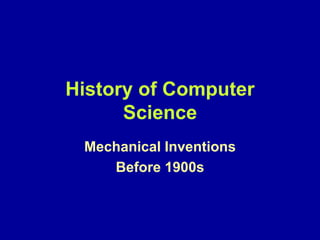
5962046.ppt
- 1. History of Computer Science Mechanical Inventions Before 1900s
- 2. Antikythera • 80 B.C.E. navigational aid • predicted motion of stars and planets
- 3. Other Early Inventions • Abacus • Astrolabe (one below dated 1212 A.D.)
- 4. John Napier 1614 Napier “bones” calculate logarithms
- 5. Blaise Pascal • Mechanical adding machine (1642- 1645), the “pascaline”
- 6. “First” Calculating Machine • Originally credited Gottfried Wilhelm Leibniz (1671) • , , • Wilhelm Schickard invented one in 1623 to calculate ephemerides
- 7. Joseph-Marie Jacquard • Jacquard loom used punched cards for patterns in weaving silk (1801)
- 9. Charles Babbage • Difference engine: calculate trigonometric and logarithmic tables (1823-1834), completed 1991 • Analytical engine: precursor to modern computer (~1834, never built) • Broke Vigenère cipher
- 10. Ada Lovelace • Interested in Babbage’s Analytical engine • First “programmer” algorithm program
- 11. William Stanley Jevons • 1869 “Logic Piano” solved Boolean logic problems (syllogisms) faster than could be done by hand – ~ 3 feet tall – keys (logical operations) + levers + letters – press keys and appropriate letters appear showing the result
- 12. Herman Hollerith • Punched cards for US 1890 census data (saved $5 Mil and several years of processing time) • Tabulating Machine Company IBM
- 14. Russell & Whitehead • 1910-1913 Write Principia Mathematica, which attempted to construct the foundations of mathematics on a rigorous logical basis. Bertrand Alfred North Russell Whitehead
- 15. Leonardo Torres y Quevedo • 1911-1913: Built some electro- mechanical calculating devices, including one that played simple chess endgames against a human.
- 16. David Hilbert (1) Is mathematics complete? Can every mathematical statement be either proved or disproved? (2) Is mathematics consistent? Is it true that statements such as "0 = 1" cannot be proved by valid methods? (3) Is mathematics decidable? Is there a mechanical method that can be applied to any mathematical assertion and (at least in principle) eventually tell whether that assertion is true or not? 1928
- 17. Kurt Gödel • Answered Hilbert’s first two questions in 1931
- 18. Alan Turing • 1936 Answered Hilbert’s last question (as did Alonzo Church) and proved the Halting Problem • 1936 Turing Machine • Breaking Enigma – 1939-40 “bombes” (secret until 1970) • 1950 Turing test for AI
- 19. 1941 Konrad Zuse • Developed the “Z3” • first operational, general-purpose, program-controlled calculator
- 20. 1944 Howard Aiken • 1943: Automatic Sequence Controlled Calculator (renamed Harvard Mark I) for simple arithmetic. • Used by US Navy for ballistics and gunnery calculations
- 21. 1946 ENIAC vs Pentium • 5000 +/second • stores 200 digits • 10ft tall, 1800 ft.2, 30 tons 150MHz 16Mb RAM IBM ThinkPad 755 CX: • 150x106 +/second • stores 16x106 digits • 11.7”x8.3”, 6.1 lbs [ENIAC considered first electronic digital computer (Mauchly & Eckert) until info. on Colossus released in 1970]
- 22. 1944 EDVAC • stored-program electronic computer • Mauchly, Eckert, and John von Neumann • Maurice Wilkes builds EDSAC in 1948 (based on EDVAC), first stored- program digital computer
- 23. Grace Hopper • Worked with: – 1944: Aiken on Harvard Mark I – 1949: Eckert and Mauchly on UNIVAC • Credited with: – 1951: first “computer” bug – 1952: first compiler – 1959: COBOL
- 24. Hardware Revolutions • 1947: Transistor invented by John Bardeen, Walter Brattain, and William Shockley who were awarded the 1956 Nobel Prize in physics. • 1949: Jay Forrester invents magnetic core memory • 1959: Jack Kilby (Texas Instruments) and Robert Noyce (Fairchild Semiconductor) invent the integrated circuit
- 25. 1950s Idea Revolutions • 1956: Edsger Dijkstra develops algorithms for minimum spanning trees and shortest path in a graph • 1957: FORTRAN by John Backus et. al. • 1958: – LISP by John McCarthy, – Algol by Alan Perlis, John Backus, Peter Naur, et. al.
- 26. 1960s • More programming languages • Fred Brooks: operating systems • Chomsky and Rabin: automata theory • Hoare: program correctness + quicksort • 1968: computer mouse by Engelbart • 1969-1971: Hoff and Faggin (Intel) design first microprocessor. • Knuth’s 3-volume “The Art of Computer Programming” • ARPAnet: precursor to Internet
- 27. 1970s • Major advances in database theory (Codd) • UNIX (Thompson & Ritchie), C (Kernighan and Ritchie) • RISC architecture • Cray supercomputers • Advances in algorithms and computational complexity (Karp, Cook) • Public-key cryptosystems (RSA) • Start of Usenet
- 28. 1980s • Rise of personal computers (Jobs and Wozniak, founders of Apple) • 1981: – first computer viruses – first successful marketable PC • 1984: Apple Macintosh • 1987: the US National Science Foundation starts NSFnet, precursor to part of today's Internet.
- 29. 1990s • Parallel computing • Biological computing e.g. Human Genome Project • Quantum computing • Growth of Internet and WWW • Size/cost decrease and power increase of hardware • Nano-technology